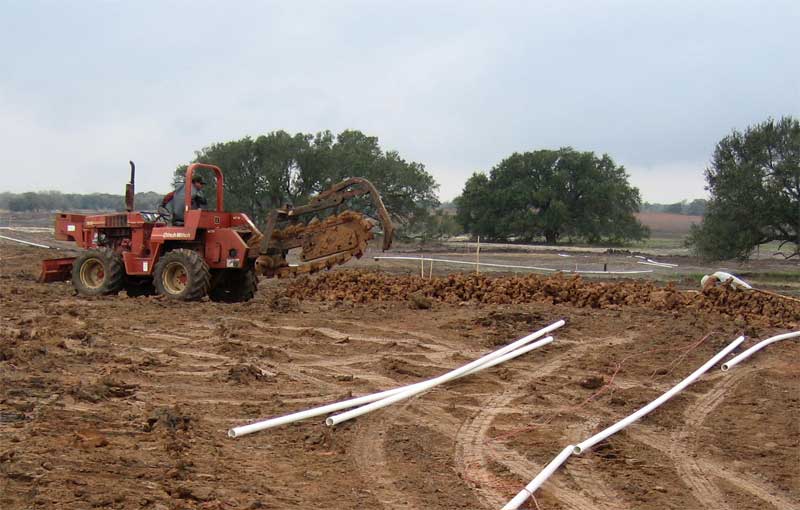 Depending on soils there are two ways to get small, lateral irrigation pipe in the ground. [laterals are the runs of pipe from the main line that connect to the head – see as-built] Vibratory plow is one method - open trenching is the other. The above picture is a trencher, and how our pipes were installed. It works like a giant chain saw and leaves a trench deep enough and just wide enough to lay the pipe and have room to route the wire and make the connections. It disturbs little material – is easy to put back – and requires proper compaction to eliminate small little impressions across all the fairways. If you have enough time it will compact in the rain.
Depending on soils there are two ways to get small, lateral irrigation pipe in the ground. [laterals are the runs of pipe from the main line that connect to the head – see as-built] Vibratory plow is one method - open trenching is the other. The above picture is a trencher, and how our pipes were installed. It works like a giant chain saw and leaves a trench deep enough and just wide enough to lay the pipe and have room to route the wire and make the connections. It disturbs little material – is easy to put back – and requires proper compaction to eliminate small little impressions across all the fairways. If you have enough time it will compact in the rain.
Wednesday, August 1, 2007
Ditch Witch - Trencher
 Depending on soils there are two ways to get small, lateral irrigation pipe in the ground. [laterals are the runs of pipe from the main line that connect to the head – see as-built] Vibratory plow is one method - open trenching is the other. The above picture is a trencher, and how our pipes were installed. It works like a giant chain saw and leaves a trench deep enough and just wide enough to lay the pipe and have room to route the wire and make the connections. It disturbs little material – is easy to put back – and requires proper compaction to eliminate small little impressions across all the fairways. If you have enough time it will compact in the rain.
Depending on soils there are two ways to get small, lateral irrigation pipe in the ground. [laterals are the runs of pipe from the main line that connect to the head – see as-built] Vibratory plow is one method - open trenching is the other. The above picture is a trencher, and how our pipes were installed. It works like a giant chain saw and leaves a trench deep enough and just wide enough to lay the pipe and have room to route the wire and make the connections. It disturbs little material – is easy to put back – and requires proper compaction to eliminate small little impressions across all the fairways. If you have enough time it will compact in the rain.
Subscribe to:
Post Comments (Atom)

Just wanted to say thanks for the blog. I just found it a couple of days ago and I'm looking forward to catching up on what I've missed so far and your future posts. Keep up the good work!
ReplyDeleteOn this particular issue, I've noticed a number of golf courses which have failed to get proper compaction over the lines. What is the best way of compacting over irrigation lines?
Taylor,
ReplyDeleteThank you.
I hope you will find the blog informative - I have a lot of data to share before we are finished - we are getting closer.
Site materials are the most important aspect of ensuring good compaction. Second is time.
The irrigation crew digs the trench and installs the system. They then replace the materials - clay, which have expanded and they leave the extras pilled on the trench. Often a vibratory compactor is used, but in our case we used a dozer to cover and then a water truck to pour water in the trench - to water settle.
As the trench is exposed to the elements - mostly rain - the trench will continue to settle and compact. A 106 year record rainfal has helped in this regard. If we see any additional settling - I would'nt know how else to get a better compaction with the same materials.
It is the same with the irrigation main line and the drainage lines.
Cheers